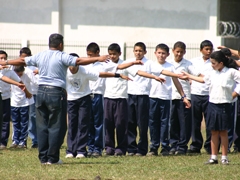By IHRSA
This past month, the President’s Council on Fitness, Sports & Nutrition (PCFSN) unveiled its new Presidential Youth Fitness Program. At first blush, it may seem like simply an update of the youth test familiar to generations of Americans. But that impression would represent a profound misunderstanding of the intent and content of the new test.
In fact, the Presidential Youth Fitness Program marks a fundamental shift in our national discourse on youth fitness.
As described in the PCFSN program materials, “The Presidential Youth Fitness Program places emphasis on the value of living a physically active and healthy lifestyle – in school and beyond.”
Furthermore, Dr. Jayne Greenberg, a member of the PCFSN and school district administrator in Miami-Dade County Public Schools, notes that the program will “focus primarily on assessing health versus athleticism for America’s youth.”

So, basically, the test is no longer a tool for determining which kids won the athletic gene pool lottery. Now it’s about assessing and tracking the health of American children. We at IHRSA wholeheartedly, unequivocally, and most enthusiastically applaud this new approach.
The need for this new test is urgent. While we celebrate the launch of the test, policymakers must also grapple with the “F as in Fat Report” released this month by the Trust for America’s Health, which suggests that adult obesity rates could reach 60% in 13 states by 2030. All 50 states, according to the report, could experience obesity rates over 44% within 20 years.
We know that the causes of sedentary, unhealthy behaviors are varied and highly individualized, but surely the stigmatization of being labeled “unathletic” at an early age lingers destructively for many older Americans. In this new era of the Presidential Youth Fitness Program, young Americans will learn that physical activity is more than just a pull-up test or rope climb. They will learn that it’s a gateway to a happier, healthier, and more productive life, regardless of one’s ability to complete 60 sit-ups in one minute.
At IHRSA, we are committed to elevating and celebrating the best health club-based youth programs.
In a recent segment of IHRSA’s “Ask an Industry Leader” series, we asked, “In a time when childhood obesity is at the forefront, what are good strategies for children/teen programming to get youth in my community more active and engaged in the club?”
Bill Parisi, Founder and CEO of Parisi Speed School, responded:
Youth fitness is all about motivation and engagement. Kids are noth thinking health and longevity, they want to have fun, be competitive, and most importantly, be accepted by their peers.” [I also encourage clubs to] make your program inviting to the non-athlete by hiring staff who truly loves kids. The program itself does not have to be overly complicated, but it should be professional. You should have a respected youth performance brand, credible staff, and an environment that is motivating and professional.
What are some other successful strategies for creating effective youth programming?